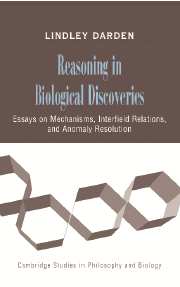 Reasoning in Biological Discoveries
Reasoning in Biological Discoveries Published online by Cambridge University Press: 31 August 2009
Philosophers of science have had relatively little to say about theory construction. Theories were treated by Popper (1965) and the logical empiricists (e.g., Hempel 1966) as if they arose all at once by a creative leap of the imagination of a scientist, a process whose study was viewed as the province of the psychologist. Only after the creative leap, they agreed, were the philosopher's logical tools useful to evaluate the theory so produced. Even more historical accounts concerned with scientific change, such as Kuhn's (1970), did not discuss the way paradigms or the theories within them were constructed, except that they somehow arose in response to anomalies of their predecessors. Lakatos (1970), who proposed criteria for evaluating progressive research programs, did not discuss how the scientist constructs the program originally, although later additions, he claimed, resulted in some way from the “positive heuristic.” Even Laudan (1977), who made much of the commonplace observation that science is a problem-solving activity, focused on the use of solved or unsolved problems to evaluate theories and research traditions; he did not provide an analysis of how a scientist goes about solving a problem. Thus, most of twentieth-century philosophy of science, from the logical empiricists to the most recent work, has been within the context of justification, not the context of discovery.
Dichotomizing science into these mutually exclusive contexts and concentrating on justification to the exclusion of discovery distorts the ongoing process that characterizes science.
To save this book to your Kindle, first ensure [email protected] is added to your Approved Personal Document E-mail List under your Personal Document Settings on the Manage Your Content and Devices page of your Amazon account. Then enter the ‘name’ part of your Kindle email address below. Find out more about saving to your Kindle.
Note you can select to save to either the @free.kindle.com or @kindle.com variations. ‘@free.kindle.com’ emails are free but can only be saved to your device when it is connected to wi-fi. ‘@kindle.com’ emails can be delivered even when you are not connected to wi-fi, but note that service fees apply.
Find out more about the Kindle Personal Document Service.
To save content items to your account, please confirm that you agree to abide by our usage policies. If this is the first time you use this feature, you will be asked to authorise Cambridge Core to connect with your account. Find out more about saving content to Dropbox.
To save content items to your account, please confirm that you agree to abide by our usage policies. If this is the first time you use this feature, you will be asked to authorise Cambridge Core to connect with your account. Find out more about saving content to Google Drive.